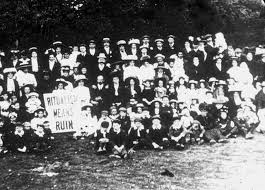Ritualism means ruin – the Thorpe War
 In England village disputes occur regularly, usually sparked by an errant hedgerow or an unpopular application for planning permission. Few though in modern times stem from religious disputes, fewer then go on to gain national attention and for a village dispute to culminate in a mass demonstration, involving crowds drawn in from far and wide numbering in the thousands, is almost unimaginable. Nevertheless, this is precisely what happened in the sleepy village of Thorpe in the early years of the twentieth century.
In England village disputes occur regularly, usually sparked by an errant hedgerow or an unpopular application for planning permission. Few though in modern times stem from religious disputes, fewer then go on to gain national attention and for a village dispute to culminate in a mass demonstration, involving crowds drawn in from far and wide numbering in the thousands, is almost unimaginable. Nevertheless, this is precisely what happened in the sleepy village of Thorpe in the early years of the twentieth century.
The roots of dispute lay in the late nineteenth century when ‘High Church’ practices, which critics felt were reminiscent of Roman Catholicism (such as the lighting of incense and candles and the wearing of surplices), were being introduced into Church of England Services by churchmen belonging to what was called the Oxford Movement.
Opposing the Oxford Movement was the ‘Protestant Truth Society’, also known as ‘Wycliffe Preachers’ or ‘Kensitites’ after founder John Kensit. Kensit opposed the consecration of both liberal and ‘ritualistic’ bishops and organised demonstrations against what he decried as ‘popery’ and ‘ritualism’. To his critics he was a fanatic and a throw-back to earlier days of religious intolerance. Often cited as being the founder of ‘political protestantism’, Kensit died of a wound inflicted in 1902 after giving a speech but his son John continued the cause.
Meanwhile, in the small village of Thorpe in 1907 Reverend Lushington was inducted as Vicar by Henry Leigh-Bennett, Lord of the Manor. Henry and his wife Emma had opted to live in Devon leasing his estate, Thorpe Place, to his father-in-law, Captain (or Commander) Price who appears, by his letters in local newspapers, to be one of the more abrasive combatants in the Thorpe War. He was also Vicar’s Churchwarden and closely allied with the Vicar, who had incurred controversy in a former parish. Add to the mix rivalry between Captain Price and Captain Scott, whose mansion of Thorpe House was directly opposite Thorpe Place, and the stage is set.
High and Low Church supporters campaigned in Thorpe during 1910, splitting opinion in the village. Matters came to a head in August and September. Captain Price evicted one of his son-in-law’s tenants from his cottage. Various reasons are cited, one being that John Potter had removed his children from Sunday School and preferred to listen to Kensit sermons in the village club, Thorpe Working Men’s Club, in what is now Morley House. The club was largely run for the local men and women by the Scott and Blackett families. The real reason for the eviction though may have been more personal. Edwin Brown, People’s Churchwarden and blacksmith, was alleged to dislike Mr Potter.
John, wife Rose, and their seven children were homeless. Their furniture was removed to the roadside by Edwin Brown, where much of it was damaged or destroyed, until Sir Edward Holden, a retired banker living nearby at Eastley End, offered sanctuary in his stable block. Mr Holden later paid for the family’s emigration to Australia as no local farmer would offer John work. Rose Potter wrote a grateful letter of thanks to him which arrived in 1912.
The first demonstration took place outside the church of St Mary, filling Church Approach; probably the largest gathering ever held there. Although both sides relied on oratory to make their point, scuffles occurred resulting in fines of £20 for seven men. The local paper reported on 10 August that the speaker was Mr Norman Chivers, Secretary of the Kensit Memorial College. Edwin Brown was referred to as ‘the great coke authority’ from his remark to an earlier campaigner, Mr Gurr, to ‘go and eat coke’. A second demonstration held on Thorpe Green on 14 September 1910 was the last major gathering but ill feeling persisted. In August 1911 the church was broken into, everything taken off the high altar and dumped in the churchyard wrapped in the altar cloth.
The Church of England village school was affected for years. In November 1910 the Diocesan Inspectors School Report mentioned religious instruction and arguments between Mr Coombe (a School Manager) and the Revd Lushington over the number of Sacraments taught. By February 1911 the argument was so serious that the Minutes could not be signed. Later that year Captain Price became another School Manager and by 1912 parents were removing their children to the new (and secular) St Ann’s Heath Board School and the reporting of Managers’ meetings was prevented. The Diocesan Board recommended separate religious instruction for Dissenters but the Managers said they were unable to comply. Questions about the problems reached a high level; by April 1914 a question was asked in the House of Commons and even after the start of the First World War, in October 1915, children were still being transferred to other schools to the disapproval of Captain Price, Rev Lushington and Edwin Brown.
After what had been a tumultuous few years the Thorpe War fizzled out. In 1917 Rev Eddrup arrived as a the new Vicar and the troubles seem to have simply died away.
Jill Williams, Egham-by-Runnymede Historical Society
